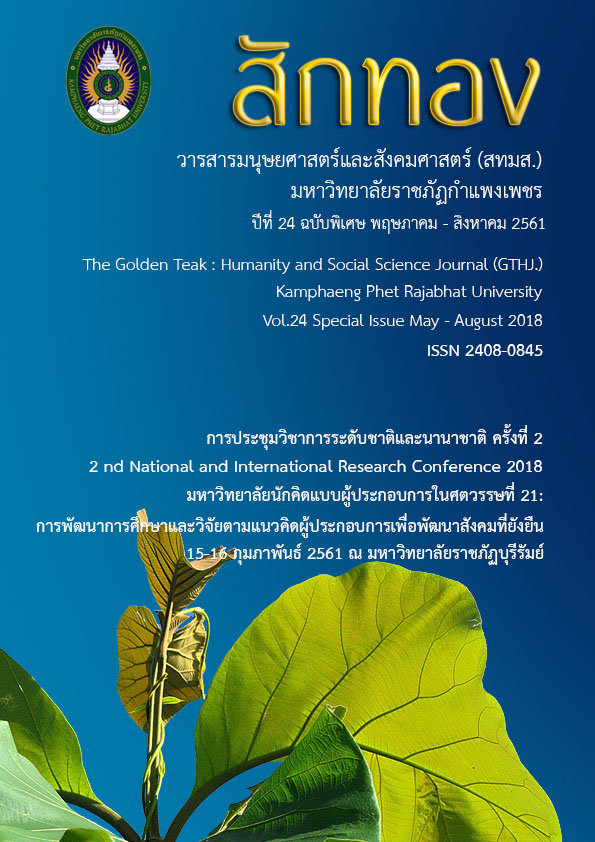An Investigation of English Listening Strategies Employed by Lao EFL College Students
Main Article Content
Abstract
This research aimed to investigate and compare the English listening strategies employed by Lao EFL college students as classified by their genders and English proficiency. The samples were 71 third year English major students studying in the first semester of the academic year 2016 at Savannakhet Teacher Training College (STTC) in Savannakhet Province, Lao PDR. They were selected by using the table of Krejcie and Morgan and a simple random sampling technique. The instrument used in this study was a questionnaire adapted from Gu (2004). The obtained data were analyzed by using mean, standard deviation, and independent samples t-test. The findings revealed that the use of English listening strategies of Lao EFL college students both in overall and each strategy was at a high level. Cognitive strategy was reported to use most, followed by meta-cognitive strategy and social affective strategy, respectively. In addition, the English listening strategies employed by these students classified by genders and English proficiency in overall showed statistically significant difference at 0.05 level.
Article Details
บทความที่ได้รับการตีพิมพ์เป็นลิขสิทธิ์ของวารสาร สักทอง : วารสารมนุษยศาสตร์และสังคมศาสตร์ สถาบันวิจัยและพัฒนา มหาวิทยาลับราชภัฏกำแพงเพชร
ข้อคิดเห็นใดๆ ที่ปรากฎในวารสารเป็นวรรณกรรมของผู้เขียนโดยเฉพาะ ซึ่งมหาวิทยาลัยราชภัฏกำแพงเพชรและบรรณาธิการไม่จำเป็นต้องเห็นด้วย
References
cognitive and affective response in second-language listening. The Modern Language
Journal, 76, 160-178.
Chao, J.Y. (1997). The influence of strategy use on comprehension and recall of authentic
listening texts by Chinese EFL students in Taiwan. Dissertation Abstracts
International, 57, 3366A.
Ehrman, M. & Oxford, R.L. (1989). Effects of gender differences, career choice, and
psychological type on adult language learning strategies. Modern Language Journal,
73, 1-13.
Ferris, D. (1998). Students' views of academic aural/oral skills : A comparative needs analysis.
TESOL Quarterly, 32, 289-318.
Gilbert, M.B. (1989). Perceptions of listening behaviors of school principals. School
Organisation, 9, 271-282.
Gilakjani, A.P. & Ahmadi, M.R. (2011). A Study of factors affecting EFL learners' English listening
comprehension and the strategies for improvement. Journal of Language Teaching
and Research, 2(5), 977-988.
Goh, C.C.M. (1998). How ESL learners with different listening abilities use comprehension
strategies and tacice. Language Teaching Research, 2(2), 124-147.
_______. (2002). Exploring listening comprehension tactics and their interaction patterns.
System, 30, 185-206.
Green, J.M. & Oxford, R. (1995). A closer look at learning strategies, L2 proficiency, and gender.
TESOL Quarterly, 29(2), 261-297.
Gu, Y. (2004). Gender, academic major, and vocabulary learning strategies of Chinese EFL
learners. RELC Journal, 33(1), 35-54.
Jing, L. (2013). An investigation and analysis of non-English specialized undergraduates'
listening strategy use. American International Journal of Social Science, 2(8),
115-125.
Krejcie, R.V. & Morgan, D.W. (1970). Determining sample size for research activities. Educational
and Psychological Measurements, 30, 607-610.
Murphy, J.M. (1985). Investigation into the listening strategies of ESL college students. TESOL
Quarterly, 12(2), 87-95.
_______. (1987). The listening strategies of English as a second language college students.
Research and Teaching in Developmental Education, 4, 27-46.
Nunan, D. (1996). The effect of strategy training on student motivation, strategy
knowledge, perceived utility and deployment. Hertford Shire : Prentice
Hinternational(UK) Ltd.
Nyikos, M. & Oxford, R.L. (1993). A factor analytic study of language learning strategy use:
Interpretations from information-processing theory and social psychology. Modern
Language Journal, 7, 11-22.
O’Malley, J.M. & Chamot, A.U. (1990). Learning strategies in second language acquisition.
Cambridge : Cambridge University Press.
O’Malley, J.M., Chamot, A.U. & Kupper, L. (1989). Listening Comprehension Strategies in
Second Language Acquisition. Applied Linguistics, 10(4), 418-437.
Oxford, R.L. (1990). Language learning strategies: What every teacher should know. Boston :
Heinle & Heinle.
_______. (1993). Research update on L2 listening. System, 21, 205-211.
Oxford, R.L. & Burry-Stock, J. (1995). Assessing the use of language learning strategies
worldwide the ESL/EFL version of the strategies inventory for language learning : SILL.
System, 23, 1-23.
Oxford, R.L., et al. (1993). Japanese by satellite: Effects of motivation, language learning styles
and strategies, gender, course level, and previous language learning experiences on
Japanese language achievement. Foreign Language Annals, 26, 359-371.
Piamsai, C. (2011). An investigation of listening strategies and listening performance of
proficient and non-proficient language learners. E-journal for Reacher Teachers, 4(1),
1-26.
Prajanban, N. (2016). English listening strategies employed by English major university
students. Unpublished Master’s Thesis in English Major, Buriram Rajabhat University.
Rost, M. & Ross, S. (1991). Learner use of strategies in interaction : Typology and teachability.
Language Learning Journal, 4(2), 235-273.
Rubin, J. (1994). A review of second language listening comprehension research. The Modern
Language Journal, 78(2), 199-217.
Vandergrift, L. (1993). The comprehension strategies of second language (French) listeners.
Dissertation Abstracts International, 54, 850A.
_______. (1996). The listening comprehension strategies of core French high schools. Canadian
Modern Language Review, 52(2), 200-223.
_______. (1997). The strategies of second language (French) listeners : A descriptive study.
Foreign Language Annals, 3, 30.
_______. (2003). Ochestrating strategy use : Toward a model of the skilled secound language
listenier. Language Learning Journal, 53(3), 168-176.
Watthajarukiat, T., Chatupote, M. & Sukseemuang, P. (2012). An investigation of English
strategies used by Thai undergrade students in public universities in the south.
Warasarnsilapasart, 4(2), 1-14.
Wolvin, A. & Coakley, C. (1991). A survey of the status of listening training in some fortune
500 corporations. USA : Communication Education.
Wu, C.H. (2007). A study of listening strategies and difficulties of high-proficiency and low
proficiency English majors in Taiwan-A think-aloud study. Unpublished Master’s
Thesis, National Changhua Universityof Education.


